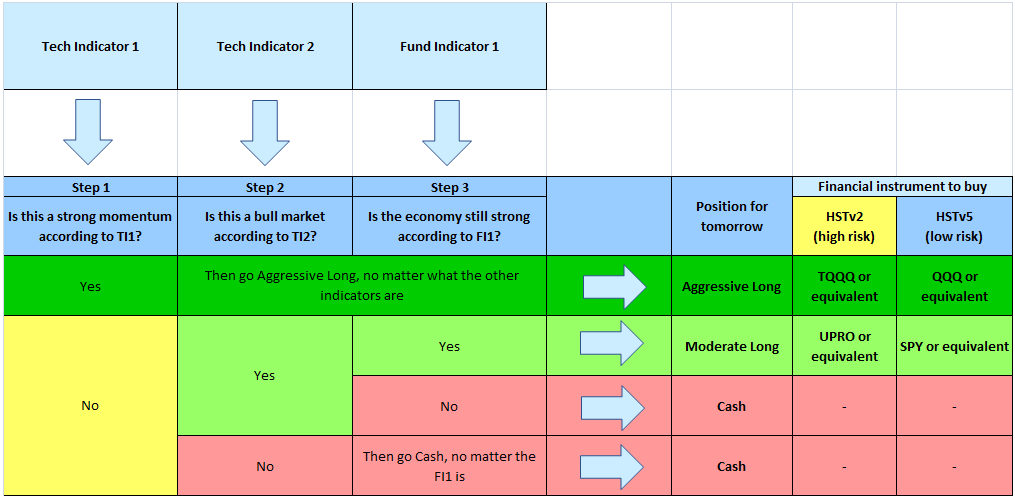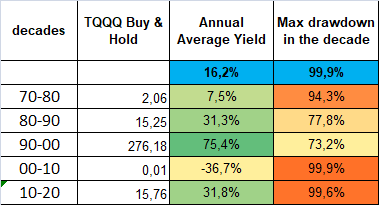What is it?
It is a trading model based on technical and fundamental parameters, which gave in backesting period (1971-2019) impressive yields and reasonable drawdowns.
How does it work?
A mathematical algorithm is behind it. It uses TA (based on price action of stocks) and FA (based on st atus and perspective of the economy).
atus and perspective of the economy).
The HST model has been backtested over the 48 past years, from 1971 to 2019, showing amazing performances, because:
- it jumps in the stock market during the main bull periods, using ETFs bound to the Nasdaq index (TQQQ-QQQ)
- steps aside when the market is more volatile, investing in ETFs bound to the S&P500 index (UPRO-SPY)
- jumps out of the market when technical and fundamental parameters suggest to (Cash)
Every day the HST model suggests a position among the three Aggressive Long / Moderate Long / CASH.
It is so simple to manage for an investor.
How good is its perfomance compared to Buy & Hold?
 A simple strategy "Buy and Hold" is often more performing than many technical signals available under payment.
A simple strategy "Buy and Hold" is often more performing than many technical signals available under payment.
It looks amazing: Buying & Holding (B&H) a 3x leveraged ETF based on Nasdaq (as $TQQQ), an investor would have hypothetically achieved an annual yield of 16.3% since 1971. [ETFs like $TQQQ did not even exist at that time]
But with one ugly side effect: during past bear markets the investor would have experienced catastrophic drawdowns: in 2001 he would have lost the 99.9% off the peak reached on March 10th 2000. And would have not recovered yet that peak, not even close (actual value is 15.76x when in 2000 it was 276.16x)
The loss suffered from the previous top is called "max drawdown" and it is one of the most important parameters to consider for a long-term investor.
So we need to make a point clear: an investor looks for a good performance, but also needs to be somehow protected from the massive drawdowns that sometimes the markets live during bear markets.
A "Buy and Hold" strategy applied to Nasdaq and hypothetically using $TQQQ, during the last 48 years would have shown
- Average annual yield 16.3%
- Max drawdown 99.9% = capital destroyed to a 0.1% from previous top
This is something that no investor can bear. We need to leave the B&H strategy, especially when using leveraged ETFs, very volatile financial instruments.
The HST model: how is it different?
 The HST model applied (backtested) on the same, long period of 48 years, has shown much better results, simply stepping out to CASH during main bear markets:
The HST model applied (backtested) on the same, long period of 48 years, has shown much better results, simply stepping out to CASH during main bear markets:
- On the 49 complete years from 1971 to 2019, it was negative for only 7 years, while 42 years were positive.
- It has doubled the capital, on average, every two years (using 3x leveraged ETFs).
- In bear markets the max drawdown suffered was 54.6%, something that the model itself would have recovered in few years.
And this happened only during worst bear markets. - In favorable periods it achieved up to 100%-200% annual performances.
- Average annual yield would have been 52.4%
- Recently (2010-2019) it is giving a 31.6% yield and manageable drawdowns.
- Note: applying the HST model with 3x leveraged ETFs ($TQQQ/$UPRO/CASH) gives much higher yield and more acceptable drawdowns, but still it is a very risky investment. An investor can apply the same model using non leveraged ETFs ($QQQ/$SPY/CASH) and consistently reducing volatility
https://hariseldontrader.joomla.com/index.php/tips-and-tricks-for-investors-blog/5-using-the-hst-model-with-no-leverage

